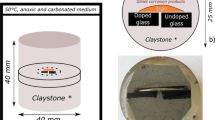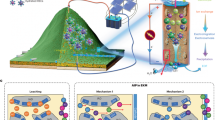Abstract
The elements occurring in high-level nuclear reactor wastes can be safely immobilised by incorporating them within the crystal lattices of the constituent minerals of a synthetic rock (SYNROC). The preferred form of SYNROC can accept up to 20% of high level waste calcine to form dilute solid solutions. The constituent minerals, or close structural analogues, have survived in a wide range of geochemical environments for periods of 20–2,000 Myr whilst immobilising the same elements present in nuclear wastes. SYNROC is unaffected by leaching for 24 h in pure water or 10 wt % NaCl solution at high temperatures and pressure whereas borosilicate glasses completely decompose in a few hours in much less severe hydrothermal conditions. The combination of these leaching results with the geological evidence of long-term stability indicates that SYNROC would be vastly superior to glass in its capacity to safely immobilise nuclear wastes, when buried in a suitable geological repository. A dense, compact, mechanically strong form of SYNROC suitable for geological disposal can be produced by a process as economical as that which incorporates radwaste in borosilicate glasses.
This is a preview of subscription content, access via your institution
Access options
Subscribe to this journal
Receive 51 print issues and online access
$199.00 per year
only $3.90 per issue
Buy this article
- Purchase on Springer Link
- Instant access to full article PDF
Prices may be subject to local taxes which are calculated during checkout
Similar content being viewed by others
References
McCarthy, G. J. Nucl. Technol. 32, 92–105 (1977).
McCarthy, G. J. et al. Nature 273, 216–217 (1978).
Ringwood, A. E., Kesson, S. E., Ware, N., Hibberson, W. & Major, A. in Scientific Advances and Community Risk (Australian Academy of Science, in the press).
Ringwood, A. E. Safe disposal of high level nuclear reactor wastes: a new strategy (Australian National University Press, Canberra, 1978).
Kärn-Bränsle-Säkerhet Report by Nuclear Fuel Safety Project to Swedish Government (AB Teleplan SOLNA Sweden Ultraoffset AB SOLNA, 1978).
McCarthy, G. J. Am. nucl. Soc. Trans. 23, 168–169 (1976).
Roy, R. J. Am. ceram. Soc. 60, 350–363 (1977).
Schwoebel, R. L. & Johnston, J. K. in Ceramic and Glass Radioctive Waste Forms, 101–112 (eds Readey, D. W. & Cooley, C. R.) (ERDA Conf. 770102, 1977).
Pudovkina, Z., Dubakina, L., Levedeva, S. & Pyatenko, Y. Zap. vseross. miner. Obshch 103, 368–372 (1974).
Author information
Authors and Affiliations
Rights and permissions
About this article
Cite this article
Ringwood, A., Kesson, S., Ware, N. et al. Immobilisation of high level nuclear reactor wastes in SYNROC. Nature 278, 219–223 (1979). https://doi.org/10.1038/278219a0
Received:
Accepted:
Issue Date:
DOI: https://doi.org/10.1038/278219a0
This article is cited by
-
A comparative study on pyrochlore phase formation in La2Zr2O7 in microscopic and macroscopic scale
Journal of Radioanalytical and Nuclear Chemistry (2024)
-
Exploring the influence of lanthanides on the structure and thermodynamic stability of SrLnTh(PO4)3 (Ln = La, Nd, Sm, Eu, and Gd)
Journal of Thermal Analysis and Calorimetry (2023)
-
Low-temperature synthesis and thermal expansion of nanocrystalline monoclinic zirconolite ceramics
Journal of Thermal Analysis and Calorimetry (2023)
-
Preparation and chemical stability evaluation of new (Nd,An)2Zr2O7-SrZrO3 multiphase ceramics
Journal of the Australian Ceramic Society (2023)
-
Preparation and characterization of multiphase ceramic designer waste forms
Scientific Reports (2021)
Comments
By submitting a comment you agree to abide by our Terms and Community Guidelines. If you find something abusive or that does not comply with our terms or guidelines please flag it as inappropriate.



